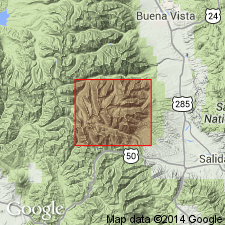
- Usage in publication:
-
- Calico Mountain Andesite*
- Modifications:
-
- Named
- Dominant lithology:
-
- Breccia
- Agglomerate
- Tuff
- AAPG geologic province:
-
- Eagle basin
Summary:
Named for exposures on Calico Mountain, the type locality, Chaffee Co, CO in the Eagle basin. Designated "andesite" by Dings and Robinson (1957). Exposed in a band 8 km long and 1 to 3 km wide from Billings basin to Browns Creek. Is typically a porphyry with a fine-grained groundmass in which altered phenocrysts of feldspar and sparse mafic minerals (1 mm) are set. Is intensely altered to an assemblage of clay minerals, chlorite, epidote, calcite, pyrite, and iron oxides. Is highly fractured. Has limonite stain or coating from the contained pyrite resulting in a characteristic brown to brown-red color. Is a highly altered assemblage of andesitic lava flows, pyroclastic breccias, laharic breccias, agglomerate, and welded ash-flow tuffs. Basal contact poorly exposed. Is against Mount Pomeroy Quartz Monzonite to northwest, and Precambrian gneissic quartz monzonite to southeast. Both of these units are older than Calico Mountain. Inliers of gneissic quartz monzonite and of Paleozoic sedimentary rocks in Calico Mountain represent exposures of the basal contact. Estimated to be 500-800 m thick. Upper surface eroded. Overlain by Sewanee Peak Volcanics at southeast end of outcrop. Geologic maps. Oligocene age.
Source: GNU records (USGS DDS-6; Denver GNULEX).
For more information, please contact Nancy Stamm, Geologic Names Committee Secretary.
Asterisk (*) indicates published by U.S. Geological Survey authors.
"No current usage" (†) implies that a name has been abandoned or has fallen into disuse. Former usage and, if known, replacement name given in parentheses ( ).
Slash (/) indicates name conflicts with nomenclatural guidelines (CSN, 1933; ACSN, 1961, 1970; NACSN, 1983, 2005, 2021). May be explained within brackets ([ ]).

